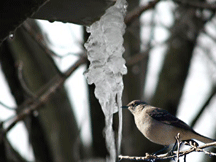
|
Volume XVII, Issue 10 - March 5 - March 11, 2009
|
|
Columns Reviews |
Bay Reflections
Lessons of the Storm
From icicles, stalactites and mockingbirds — how we learn
by Ricky Rood
This morning I opened the blinds on the windows that look to the south, across the field, onward to Chesapeake Bay. The snow from the storm was deep enough to cover the stubble of the summer’s corn. At the shore, the smooth white broke into the rough Bay ice cracked and stirred by the tides and waves. Beyond, the clear wintertime water of the Bay mixed with the blue of the sky.

![]() A curtain of ice folded over the edge of my roof, making a thick knobby pane bright with the morning sun. The edge of the curtain shredded into a vicious fringe of glowing icicles. Below, from the holly bush, a mound of clouded ice was building upward on the tip of a branch. A tenuous thread of ice connected the longest icicle with the mound.
A curtain of ice folded over the edge of my roof, making a thick knobby pane bright with the morning sun. The edge of the curtain shredded into a vicious fringe of glowing icicles. Below, from the holly bush, a mound of clouded ice was building upward on the tip of a branch. A tenuous thread of ice connected the longest icicle with the mound.
A mockingbird landed less than two feet from my eyes. A drop of water splashed on its head, beading on its feathers. The bird, tailored in gray and white, reached and drew from the reliable stream of water running down the ice. Time and time again, the bird took long drinks. Occasionally a drop would land on its tail, another on its head, never startling the bird with its seemingly desperate thirst.
Does the bird simply search for water by sight, smell or sound, or does it know to go looking for icicles? Does it learn to look for icicles wherever it flies during the day? Or once it finds the source on my holly bush, does it only return? Is every new thirst another search?
As Close As We Get to Truth
The spikes of ice hanging from my roof and the little mounds on the holly bush are like the lime and mineral deposits in caves. Stalactites hang from the ceiling, and stalagmites reach up from layered mounds on the floor. Rock-cicles formed by slow drips, each on their own seeming to fall away but leaving a little relic that accumulates into brittle Gothic gardens.
Did we have to understand icicles before we understood the caverns? As a scientist, I often wonder whether, if we had not seen the birds flying, would flight have ever entered our minds. Can we only grasp the unknown with building blocks of the known?
The powdery snow has been moved around not only by plows but also by days of cold winds. In the building where I work, four wings are arranged like fingers spread apart. Within the space between the wings, there have been whirlpools of air filled with snow. All of the snow has been moved from one side, leaving bare ground to the other side, patterned in graceful dunes.
These dunes are little different in form from the sand dunes of Death Valley. In fact, away from the dirty piles of icy rubble that line the streets and parking lots, you can see the American West in the snow. Dunes, slot canyons, hoodoos and spires are sculpted and dripped next to retaining walls, behind piles of construction gravel. Everywhere there are edges in the wind. It makes you believe in geology.
Lessons come from observation, and applying those lessons to understanding other phenomena is one of the paths of science. We try to challenge those lessons. How well do they apply; how well do they generalize? If the lessons work, then we start to believe we understand, start to believe that we can predict. When the old lessons fail, we learn something new.
We all have stories of blizzards that arrive, unannounced, from the south. Sometimes, we prepare for snow that never comes. The failed predictions are used to chide the weather forecasters. Meteorology is a science that, more than most, reveals its warts when the old lessons fail.
Most physical science is deliberated in the arcane machinations of peer-reviewed journals, but meteorological failures play out with full and instant television coverage. Despite all of the glory and boast of supercomputers and sophisticated mathematical models, we are reminded that we are simulating a complex, perhaps chaotic, reality, using the best approximations that we can afford, that we can understand.
Approximations.
The sophisticated models represent the lessons we have learned expressed as mathematical equations. The crudeness of the approximations and assumptions in the models sometimes surprise us with harsh, brilliant ice.
It is pleasing to see Death Valley’s Eureka Dunes in the striated snow of your yard and think you understand the circumstances of mountain ranges and winds that build waves of sand 700 feet high. But you only can go so far trying to explain stalactites as stone icicles. We have to dissect and examine the similitude. Otherwise, every new thirst is a new search, and soon we learn to only stay close to our holly bushes and drink from the stream that we know.